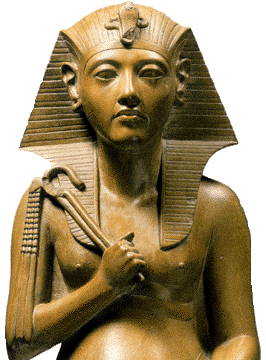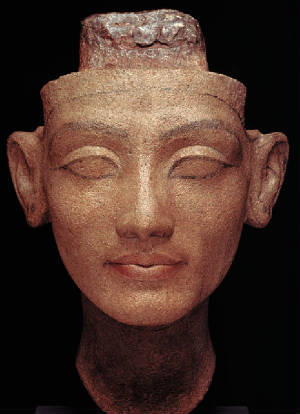|

Becoming Pharaoh
Akhenaten's older brother, Prince Tuthmose, was the recognized
heir of Amenhotep III. Little more is known of the prince, and it is presumed that he died while young for reasons unknown,
in about Year 27 (c. 1365 BCE). Akhenaten became pharaoh about 12 years later. There is a question of whether there was a
short period of co-regency with his father, which would not have been unusual, particularly for a young pharaoh. Akhenaten
was married to Nefertiti at the beginning of his reign, and they had six daughters--Meritaten, Meketaten, Ankhesenpaaten,
Neferneferuaten-the-younger, Neferneferure, and Setepenre. He may've also had two sons from Kiya, a lesser wife.
Since Akhenaten was not originally designated to be the heir to the throne, he may have been training for the priesthood
when Thutmose died. At the beginning of his reign, he was known as Amenhotep IV, but because of his devotion to the god
Aten, he changed his name to Akhenaten. Amenhotep means "Amun is pleased," in reference to the supreme deity at the time.
Initially, Akhenaten presented Aten as a variant of this deity, also known as Amun-Ra. Ra was god of the sun and Aten was
the light within the sun disk.
 Subsequently, Akhenaten declared that Aten was not only the supreme god, he was the only
god. He closed all temples in Egypt dedicated to other gods and banned idols with the exception of the symbol that represented
Aten--a rayed solar disc with a hand at the end of each ray, which he proclaimed the best natural symbol of the invisible,
universal, and sole god Ra. These actions created many enemies, the priests of Amun foremost among them.
|

